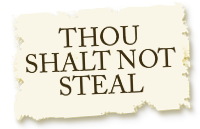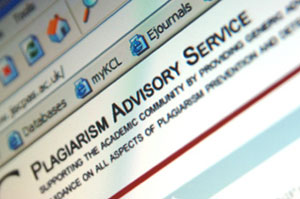Avoiding Plagiarism

Source: Thou Shalt Not Steal, IPSI
“I’d rather be caught holding up a bank than stealing so much as a two-word phrase from another writer.”
“Your manuscript is both good and original; but the part that is good is not original, and the part that is original is not good.”
Samuel Johnson
As noted by both contemporary author Smith and the unknown eighteenth-century author, plagiarism is NOT your friend! Plagiarism is a form of academic dishonesty in which a writer uses other people’s words or ideas (pictures, art, charts, graphs, computations, scientific data, music, etc.) as his or her own. The writer may do this by failing to credit the others at all or by improperly crediting the creator. If you use someone else’s exact words, put quotation marks around them and give the person credit by revealing the source in a citation. If you use someone else’s ideas or revise, rearrange, or paraphrase their words, you still must cite your source. Otherwise, you imply that the words or ideas are your own.
Some plagiarism is blatant and intentional. Unscrupulous students have been known to buy, steal, or copy an entire paper from the Web. You commit plagiarism if you hire someone to write your paper, copy chunks of someone else’s work without documentation, or cite fake information. Some plagiarism might be considered unintentional, such as missing or improperly citing a source due to carelessness (perhaps because a student is hurrying to do an assignment at the last minute). It may be possible to accidentally paraphrase too closely to the original’s wording—so closely that quotation marks should have been used. Or a writer might use other writers’ ideas by mistake without giving them credit. Sometimes teachers or administrators will try to ascertain whether a student intended to cheat, but some may say that any kind of plagiarism, intentional or not, is still plagiarism.

Source: Screenshot053, Jisc, Flickr
With that in mind, let’s look at ways to avoid even being suspected of plagiarism in the first place.
Begin with the chart “Deciding When You Need to Give Credit,” in the previous section. When you know the theory behind what you have to document, you can create a real-world plan, a no-way-am-I-going-to-plagiarize process, using the chart below.
This lesson is in both the writing and research modules, so the message is doubly loud and clear: You must learn how to collect and use source information ethically. It’s never too early to make a plan of action to ensure you accomplish these tasks successfully.
Making sure you are safe
Action during the writing process |
Appearance on the finished product |
|
|
When researching, note-taking, and interviewing
|
|
- Works cited page - Quotation marks - Indirect quotations |
|
When paraphrasing and summarizing
|
|
|
|
When quoting directly
|
|
|
|
When quoting indirectly
|
|
|
From Pearson Online
As you can see, avoiding plagiarism is even part of the proofreading process. However, since we’re planning ahead, it is wise to have a checklist to refer to during the entire writing process, not only at the end, to avoid inadvertent plagiarism. The Pearson Education Web site contains an extremely helpful checklist.
For information about how to punctuate quotations, see the lesson titled “Proofreading for Spelling, Capitalization, and Punctuation.”